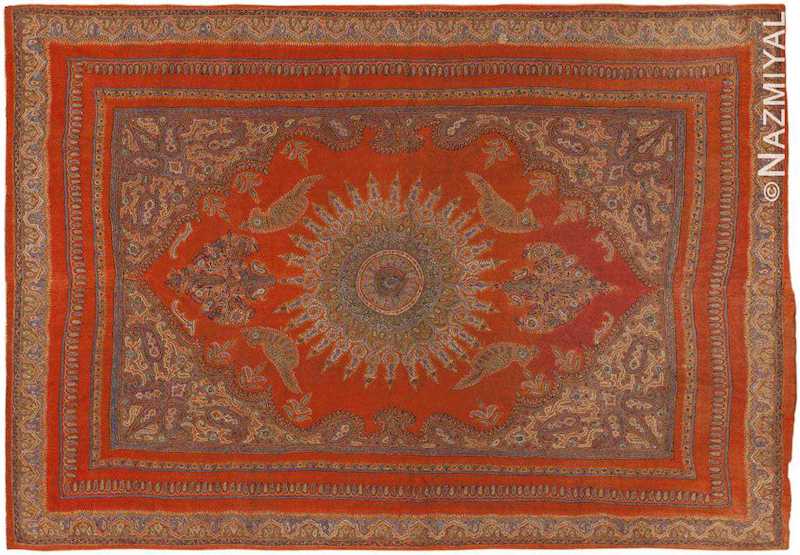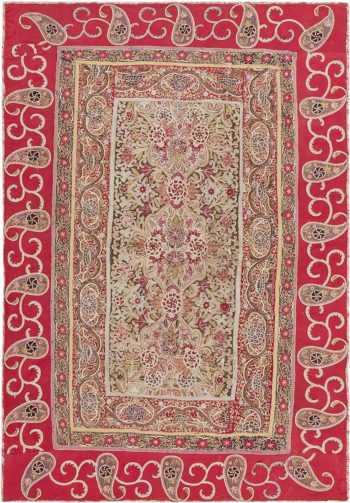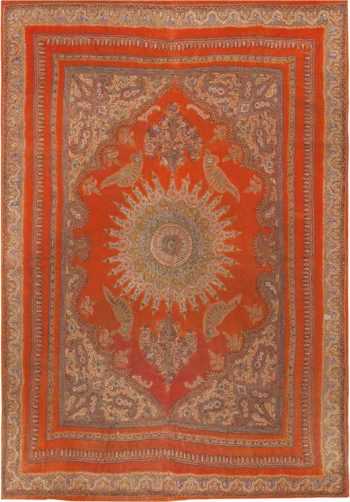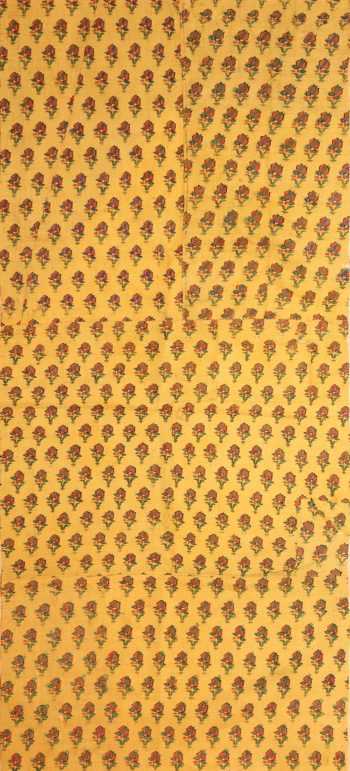Shawls
View our current selection of antique Shawls below:
Antique Persian Paisley Rashti Embroidery Textile 46521
$5,900.00Size: 3 ft 10 in x 5 ft 7 in (1.17 m x 1.7 m)Antique Intricate Persian Isfahan Paisley Bird Design Shawl 45777
$5,600.00Size: 3 ft 10 in x 5 ft 7 in (1.17 m x 1.7 m)Antique Silk Kashmir Mughal Shawl 49092
$2,600.00Size: 1 ft 4 in x 3 ft (0.41 m x 0.91 m)Long and Narrow Open Field Antique Indian Paisley Shawl 45486
Size: 7 ft 7 in x 1 ft 1 in (2.31 m x 0.33 m)
Learn More About Antique Shawls
What Are Shawls?
Shawls are large pieces of fabric that are typically worn over the shoulders or wrapped around the body to provide warmth or to accessorize an outfit. They are usually made of soft, warm materials such as wool, cashmere, silk, or acrylic.
Shawls come in various shapes, sizes, and designs. They can be square, rectangular, triangular, or even circular. Square and rectangular shawls are the most common and versatile, as they can be worn in different ways, such as draping them over the shoulders, wrapping them around the neck, or even using them as a head covering.
Triangular shawls are often referred to as “scarves” and are worn by both men and women. They can be worn by draping the longest side over the shoulders and tying the ends at the front or by wrapping them around the neck for added warmth.
Shawls can be plain or adorned with patterns, prints, or decorative elements such as fringes, tassels, or embroidery. They are available in a wide range of colors, allowing individuals to choose a shawl that complements their personal style and outfit.
Aside from providing warmth, these captivating textiles can also be used as fashion accessories to enhance an outfit, add a pop of color, or provide a touch of elegance. They are versatile and can be worn on various occasions, from casual outings to formal events.
In different cultures, shawls hold cultural significance and may be associated with traditional attire or customs. They are often cherished as heirlooms, passed down through generations, and can carry cultural or sentimental value.
Overall, these magnificent pieces are fashionable and functional accessories that can be worn in multiple ways to add style and warmth to an outfit.
The Beautiful Antique Shawls
Throughout the 19th century, Kerman a province in southern Iran was celebrated for its exquisite Persian / Kerman shawls rather than for carpet weaving. These antique shawls – which are beautiful, ethereal works of art – were complex in their use of traditional Persian floral patterns, French red roses known as Gol Farang, Boteh (paisley), Sarri Boteh (cypress like paisley), tree of life, vase, nightingale, and garden design.
The tight overall pattern and fineness of the weave is complimented by a delicate and harmonious color palette. Not surprisingly, the primary designs of Kerman carpets were adapted from these shawls. And when the growing demand for oriental rug production increased these experienced weavers turned their attention and talents to the carpet weaving.

Antique Persian Esfahan Shawl (sold)
Shawls Around the World
Shawls drape loosely over the head or can be work draped over just the shoulders. There is no denying their beauty and the skill of the workmanship, but shawls are more than a piece of clothing. In many cultures around the world, these textiles have a special meaning in religious and secular life.
The word shawl originates from the area of Hamedan, Iran. It is thought to have originated in the 14th century and referred to pashmina goats, or Kashmir (cashmere). The wool of these goats is extremely soft, warm, and strong. It is said that the cashmere shawl industry began when Sayeed Ali Hamadani gave a pair of cashmere socks to the Sultan. The Sultan was impressed, and it was suggested that they begin a shawl-weaving industry using this wool.
This is the story of how the pashmina shawl industry began, but it also suggests that shawls were a part of the culture before this time. The first use of of these types of pieces is attributed to the Assyrians as early as the 25th century BC. Kashmir was an area where many goods passed between India and Persia, and so it was with the fine tradition of shawl weaving.
India, Persia, and Turkey are known for the beautiful and colorful shawl designs. Some of the most expensive shawls in the world are created from the under fleece of the Tibetan antelope. They are called “shahtoosh” and are so fine that they can be passed through a small finger ring.
The invention of the Jacquard looms in the early 19th century allowed Indian weavers to adopt a wide range of gorgeous, sinuous floral designs. These fine wool shawls would soon become a luxury item in Europe and throughout the world. A finely woven shawl became a fashionable wrap for French and English women of the elite by the 18th century. You can find many beautiful examples in portraits of the time.
The boteh, or paisley design, cypress trees, and other familiar Persian motifs began to appear in Indian shawls. These symbols have significant meanings. The boteh is the eternal flame of life or seed. The cypress tree represents longevity. In earlier examples, the designs were rather sparse, but as time went on, they became more densely packed. The designs also became more detailed. For instance, rather than just the outline of a tree, you began to see leaves, fruit, and birds within its branches.
Shawls protect the person from the hot sun and elements. They are also used for modesty among those who practice Islam. Examples that feature the iconic Prayer designs have also been a part of many religions going back centuries, such as the prayer shawl, or tallit, worn by Jewish men. Some cultures incorporate these artistic textiles into their national folk dress, such as Andalusia and certain parts of Latin America.
Shawls are a traditional part of many cultures around the world. They are loved by many, and great effort has gone into creating artwork that is simply breathtaking. We hope that you enjoy our collection of fine examples from around the world. Perhaps, you would like to make one part of your collection for those special occasions.




